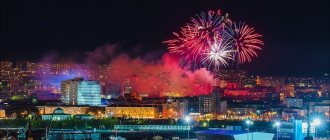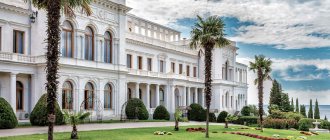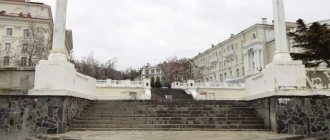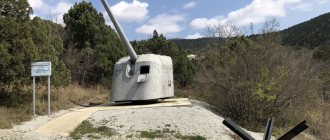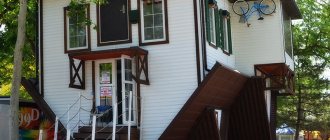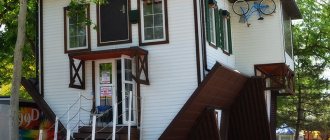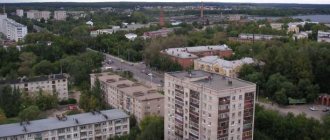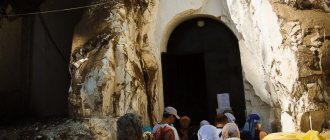| Sergiev Posad. View of the Trinity-Sergius Lavra |
Sergiev Posad
, a city of regional subordination in Russia, the administrative center of the Sergiev Posad district of the Moscow region, the center of the Sergiev Posad deanery, the cathedral city of the Sergiev Posad diocese. Located on the southern slope of the Smolensk-Moscow Upland, on the Kanchura River and its tributaries, 71 km northeast of Moscow. Railway station on the Moscow-Yaroslavl line. Population 104.6 thousand people (2017).
- On the map: Yandex.Map, Google map
Initially - several settlements that arose at the end of the 14th - beginning of the century around the Trinity-Sergius Monastery, founded in the 1340s by St. Sergius of Radonezh.
Thanks to the influx of pilgrims, trade and folk crafts developed here in the 15th-16th centuries, mainly artistic wood carving (Bogorodskaya carving, named after the nearby village of Bogorodskoye, is especially famous) and the manufacture of wooden toys. By the beginning of the 18th century, settlements around the monastery (the village of Klementyevo
and
Kokuevo
;
settlements: Pushkarskaya
,
Streletskaya
,
Ikonnaya
,
Povarskaya
,
Konyushennaya
) merged into a single settlement, which from March 22, 1782, by decree of Catherine II, began to be called
Sergievsky
(or
Sergiev
)
Posad
. as part of the Dmitrov district of the Moscow province. In 1792, the settlement acquired a regular plan. In 1845, a highway was built connecting Sergievsky Posad with Moscow. In 1862, the railway connecting Moscow with Yaroslavl passed through the settlement. Local residents were engaged in trade and serving numerous pilgrims.
In 1919 it received the status of a city and the name Sergiev
, simultaneously becoming the center of the county of the same name.
In 1930 it was renamed Zagorsk
, after the pseudonym Zagorsky of the secretary of the Moscow Committee of the RCP (b) V. M. Lubotsky, who died as a result of a terrorist attack in 1919. In 1969, the city of Zagorsk, the only city in the Moscow region, was included in the Golden Ring of Russia.
On September 23, 1991, the historical name of Sergiev Posad
.
Statistics
- 1856 - 12.1 thousand people, 10 churches, 705 houses, 57 shops
- 1897 - 25 thousand people
- 1931 - 23.7 thousand people
- 1959 - 75.6 thousand people
- 1970 - 92.4 thousand people
- 1989 - 114.7 thousand people
- 2005 - 114.1 thousand people
History of Zagorsk
The city developed around the Trinity-Sergius Lavra, so their stories largely coincide.
In 1337, in a deep forest, the ascetics brothers Stefan and Bartholomew built a cell and a small Trinity Church. Stefan soon left, and Bartholomew became a monk, taking the name Sergius, and spent several years as a hermit. Gradually, monks from nearby areas began to join him. Sergius set a condition for them - to earn a living through their own labor. Crafts began to develop here, including in settlements outside the monastery walls.
Sergius gained wide fame for his righteous life and peacemaking. Many times he had to reconcile the Russian princes. Trinity Monastery gradually turned into the spiritual center of Russian lands. It was here in 1380 that Sergius blessed Dmitry Donskoy before the Battle of Kulikovo.
(928 kb)
After the death of Sergius in 1392, he was buried on the territory of the monastery, and 30 years later he was canonized. Between these two events, in 1408, the wooden Trinity Monastery was burned by the troops of the Golden Horde Khan Edigei.
A few years later, the monastery buildings began to be restored. And over the grave of Sergius the stone Trinity Cathedral was erected. Thanks to the support of the Russian princes, the restored monastery developed rapidly. He owned the surrounding courtyards, arable land, and meadows.
In the middle of the 16th century. Ivan the Terrible ordered the monastery lands to be surrounded by powerful stone walls with towers. In the 17th century The monastery, which turned into a citadel, withstood a months-long Polish-Lithuanian siege. Here, royal figures, including Peter the Great, repeatedly took refuge from opponents and rivals.
In 1744, the monastery received the honorary status of a monastery. In 1782, it, together with the numerous surrounding settlements, became the populated area of Sergiev Posad. The monastery played the role of a city-forming factor. The new status became an impetus for further development and prosperity. It became widely known as a center for the production of toys, in particular the famous matryoshka dolls.
With the establishment of Soviet power, the religious life of the Lavra ceased. A museum was founded there, and the monks were dispersed or repressed. From 1930 to 1991 the city was called Zagorsk in honor of a prominent Bolshevik. At the same time, the city economy continued to develop successfully. Since 1946, as part of a softening of state policy towards religion, monks appeared here again and worship services resumed. But the entire Lavra complex was returned to the church only in post-Soviet times.
In 1988, as part of the celebration of the thousand-year anniversary of the baptism of Kievan Rus, a monument to Sergius of Radonezh was opened in Zagorsk. And three years later the city returned its historical name.
mass media
Printed publications
- "Forward". Municipal socio-political newspaper, published since 1918
- "Sergievskie Vedomosti". Official publication of the administration of the urban settlement of Sergiev Posad
- “Everything for you - Sergiev Posad.” Large circulation free and paid advertising and information newspaper
Broadcasting
- "Radio Posad". 90.6 MHz. On air since 2005. Private radio station. The main broadcast format is music, entertainment
A television
- "TVR - Television Radonezhye". Broadcasting since May 7, 1999. Network partner - Interstate TV and Radio. The founder of the TV channel is the Administration of the Sergiev Posad municipal district of the Moscow region. Employees of the TV channel became laureates of TEFI-Region competitions four times
- TK "Tonus" Broadcasting since 1989. Repeated winner of awards and festivals
Holy Trinity Lavra of Sergius and the relics of Sergius of Radonezh
On the territory of the oldest and largest Russian monastery there are more than fifty buildings. The oldest surviving building of the Lavra is the Trinity Cathedral, built in 1422–1425. In it, in a silver shrine, the most valuable relic is kept - the relics of Sergius of Radonezh. The horizontal iconostasis of the temple, containing 40 icons, was painted by Andrei Rublev. His famous work “Trinity”, now located in the Tretyakov Gallery, was a decoration of the cathedral before the October Revolution.
In 1476, a stone Spiritual Church was erected on the site of the wooden one. At the base of this skyward building is an open belfry, in the spans of which bells hang. Many times they had the opportunity to notify the brethren and the surrounding population of danger.
Another central building is the Assumption Cathedral, built in 1585 by order of Ivan the Terrible in memory of the capture of Kazan. The model for the beautiful white stone building with a central golden and four blue domes with stars was the cathedral of the same name in the Moscow Kremlin.
At the end of the 17th century. The monastery refectory with the Church of St. Sergius of Radonezh was built. Its gilded iconostasis from the same century, installed in the church in 1948, previously belonged to a destroyed Moscow church. In the 17th century The Royal Palaces were built to receive royalty and their high-ranking guests. After some time, the Theological Academy was located here.
In the 18th century The architectural ensemble of the Lavra was complemented by a five-tiered 88-meter bell tower with a chiming clock and 42 bells. The main ones - the largest in Russia, the 72-ton Tsar, Blagovestnik (35.5 tons) and Pervenets (27 tons), were restored at the beginning of this century. The bell tower can be visited by healthy people aged 7 to 60 years. The recommended donation amount for an adult is 200 RUR, for a schoolchild – 100.
Behind the bell tower is the Smolensk Church in the Baroque style. It was built at the expense of the favorite of Empress Elizabeth Petrovna, Count Razumovsky. According to rumors, it was in this church that their secret marriage took place.
Entrance to the territory of the Lavra is free for Russian citizens. On the Lavra website you can book group excursions - sightseeing (1600 RUR), extended (2800) and “One day in the Lavra” (8000 RUR).
The main observation deck, from which the magnificent architectural ensemble of the Lavra can be clearly seen, is located on Pancake Hill. The site was created for the Moscow Olympics in 1980. In 2014, the sculpture “Sergius and the Pigeons” was installed here. According to legend, singing birds flocked to the saint, whose prayers for his disciples were heard.
Transport
The city is home to the Sergiev Posad railway station and the Semkhoz platform of the Yaroslavl direction of the Moscow Railway, as well as the Naugolnaya and 40 km platforms of the Big Ring of the Moscow Railway.
Urban, suburban and intercity passenger transport services have been developed. In urban transport, there is a noticeable predominance of minibuses. The main carrier in the city and region is motorcade No. 1791, a branch of the State Unitary Enterprise MO Mostransavto. The most important destinations of intercity and long-distance commuter buses are Dmitrov, Bogorodskoye, Remmash, Krasnozavodsk, Khotkovo, Skoropuskovsky, Peresvet, Kalyazin, Kashin, Pereslavl-Zalessky, Moscow (direct flights); Rostov, Yaroslavl, Kostroma, Uglich, Rybinsk (transit flights).
Motorization (saturation with motor transport) of the city, according to official data for 2015 (AUTOSTAT), is 426 cars per 1000 inhabitants (vehicles/1000 people). Dynamics of motorization: 2010 - 327 cars/1000 people; 2011 - 352 cars/1000 people; 2012 - 368 cars/1000 people; 2013 - 385 cars/1000 people; 2014 - 411 vehicles/1000 people; 2015 - 426 vehicles/1000 people.
From Moscow, from the station. m. VDNKh there is a commercial bus No. 388 to the station. Sergiev Posad. The movement interval is 15-20 minutes. You can get there by train - from the station. "Moscow (Yaroslavsky Station)" to the station. "Sergiev Posad", travel time - from 1 hour 5 minutes to 1 hour 45 minutes. (depends on the number of stops and type of train).
Museums in Sergiev Posad
Two museums of the city are widely known - the Historical and Art Museum and the Toy Museum.
State Historical and Art Museum-Reserve
The History and Art Museum has been operating since 1920. At first, it displayed the treasures of the Trinity-Sergius Lavra, which closed until 1946. Subsequently, the collection was replenished with exhibits from local history museums and the capital's Museum of Folk Crafts.
Now the Historical and Art Museum-Reserve is one of the largest collections of Russian art. It consists of four buildings. The main one is located at 144 Krasnoy Armii Ave. Its exhibition hall displays paintings, graphics and decorative works by Russian artists.
The “Sacristy” building is located directly in the Lavra, in the monastery Sacristy and the Vicar’s chambers. The oldest exhibits date back to the 14th century. On display you can see icons, medieval manuscripts and books, gold and silver items, and artistic embroidery. Many components of the collection are donations from monarchs and noble families.
The Local History Building occupies one of the most famous buildings in the city at Ovrazhny Lane, 9A. It was built in 1937 in a neoclassical style with elements of constructivism. For six decades there was a kindergarten there. Now the Archaeological Department and the Department of History and Culture of the 20th–21st centuries are located here.
The name of the building is “Horse Yard” at the address: st. 1st Shock Army, 2, is associated with the once-extensive stable farm of the Lavra. After the restoration of the building, ancient archaeological finds, household items of the 19th century, peasant costumes and hats, and products of masters of decorative and applied arts were housed here.
A single ticket for all expositions and exhibitions will cost 600 RUR. The cost of an individual ticket for one exposition or exhibition is 100 RUR, with excursion service – 150 RUR, and a family ticket – 250 RUR.
Toy Museum in Zagorsk
The Artistic and Pedagogical Toy Museum was founded in 1918 by collector, artist, and art critic Nikolai Bartram in Moscow. The basis of the exhibition was his collection of toys, as well as portraits of children by Russian and Western European painters of the 18th–19th centuries. Since 1931, the Museum moved to Zagorsk, where it was located in an old mansion opposite the Lavra. The city was not chosen by chance. Matryoshka dolls have been made here for a long time, and wooden toys for children were made by Sergius of Radonezh.
Now the Museum houses 30 thousand different toys. They are divided into sections of Russian folk toys, oriental toys (Japanese dolls predominate), New Year and Christmas toys, Russian and Western European toys of the 19th–20th centuries. The toys of the children of the last Russian emperor are on display, as well as the first matryoshka doll, which turned 110 years old. The famous Mishka, the symbol of the Moscow Olympics, also settled here in his homeland.
There is a puppet theater at the Museum, and children are involved in its performances. You can also take part in master classes on toy making.
Address: Red Army Ave., 123. The museum is open Wednesday – Sunday from 10 am to 5 pm. Ticket prices for adults are 150 RUR, school and student tickets are 80, and children under 7 years old can enter for free.
Industry and manufacturing
Factories and enterprises
- Electromechanical (formerly Zagorsk Electromechanical Plant);
- Rubber Industry Research Institute;
- Zagorsk Optical-Mechanical Plant (since 1936), part of the Schwabe holding
- Research Institute of Applied Chemistry;
- Zagorsk paint and varnish plant;
- 12 Central Research Institute of the Ministry of Defense;
- ;
- Mechanical engineering (motor pumps, disinfectants);
- Chemical;
- Furniture;
- Chipboard plant;
- Electrical (heating elements);
- CJSC "Metallotorg" (metal depot, branch);
- Sewing factory for people with disabilities;
- Sergiev Posad meat processing plant;
- Sergiev Posad bakery;
- Confectionery production of JSC "Phoenix";
- Toy production plant;
- Factory of artistic carving;
- Ice Cream 2000 ice cream plant;
- Plant of reinforced concrete products;
- Portmauld mold manufacturing company;
- Drinking water production plant;
- Enterprise for the production of forged products;
- Zagorsk Pipe Plant.
What to see in Sergiev Posad in one day
In Sergiev Posad and its surroundings you can see many other interesting places, the most notable of which will be discussed below.
In 2000, on Krasnogorskaya Square near the entrance to the Lavra, a monument to Sergius of Radonezh was erected. The 5-meter-tall monument depicts a saint in monastic robes. In his left hand is a scroll with the rules he compiled for the monastic brethren, and his right hand blesses tourists and pilgrims going to the Lavra.
Not far from the Lavra is the Spaso-Vifansky Monastery, built at the end of the 18th century and operating until 1918. Its two floors had a thematic focus. The second floor was dedicated to the Transfiguration of the Lord, which took place on Mount Tabor. An iconostasis was located on its artificial model. The first floor depicted the Raising of Lazarus in Bethany. Now the former monastery is a courtyard of the Lavra.
In 1954, the impressive House of Culture, designed by the architect Nikolai Metlin, opened in the city. This secular building has become a new landmark of Sergiev Posad. Marble stairs, stucco decorations, and a huge crystal chandelier gave the building a solemn and festive look. Many leading musical and dramatic groups performed in the House of Culture, which later received the name of Gagarin and the status of a federal architectural monument.
In 2014, a reconstructed city fountain with light and music lighting was opened on the square near the House of Culture, which successfully complemented the ensemble.
In the middle of the 19th century. Gethsemane (Chernigov) monastery was founded 3 km from the Lavra. Thousands of Russian pilgrims turned to the elders who settled here for advice and blessings. A copy (list) of the famous icon of the Chernigov (Ilyinskaya) Mother of God was kept in the Cave Church built by the hermits. At the end of the 19th century. The church became the altar of the Chernigov temple built above it. Under the monastery there is another underground temple.
The city of Khotkovo, located 11 km from Posad, is known for the oldest Pokrovsky Monastery in the Moscow region, founded in 1308. Sergius’s parents were buried there, and his elder brother Stefan was tonsured a monk. Since 1544, the initially mixed monastery was subordinated to the Trinity-Sergius, and became exclusively female. Lace makers and gold seamstresses invited by Peter I from Holland taught the nuns their art.
14 km from Sergiev Posad, near the village of Vzglyadnevo, there is the Gremyachiy Klyuch spring. Water falls from a crevice from a height of 25 m. According to legend, the spring began to flow after Sergius’ prayer, and has healing properties. A log chapel-font was built near the crevice. The water temperature is constant all year round and is 6°C.
Science and education
- Sergiev Posad Humanitarian Institute
- Sergiev Posad Agrarian College
- Moscow Regional Vocational College (MOPC)
- Branches: All-Russian State Institute of Cinematography named after S. A. Gerasimov (VGIK); (college, former Zagorsk Film College)
- Sergiev Posad branch of the Higher School of Folk Arts (college of toys)
- Moscow Institute of Economics, Management and Law;
- Moscow Pedagogical State University;
- Moscow Finance and Law University (MFUA);
- Sergiev Posad branch of GBPOU MO "Moscow Regional Medical College No. 4" (former medical school (technical school);
- Moscow State Industrial University (closed);
- Moscow State University of Instrument Engineering and Informatics (student enrollment stopped);
Research institutes
- Research Institute of Applied Chemistry
- Federal Scientific RAS (Department of Agricultural Sciences)
Headed by Academician V.I. Fisinin.
- Rubber Industry Research Institute
- All-Russian Research Institute of Products for Children
How to get from Moscow to Sergiev Posad
Trinity-Sergius Lavra is a complex of existing Orthodox churches. Divine services are held here daily. On October 8 (the day of memory of Sergius) and July 18 (the day of the discovery of his relics) they take place with the participation of the Patriarch. The Lavra is open all year round from 5 am to 9 pm.
The sights of Sergiev Posad are off-season and attract lovers of educational tourism all year round. According to reviews from most travelers who have visited here at different times of the year, the preferred time to visit is winter. The snow-covered Lavra looks like it came down from heaven. In addition, winter in Sergiev Posad is mild and not very cold.
Tourists and pilgrims can travel from Moscow in 1–2 hours in several ways. The most convenient way is by train from Yaroslavsky station. Departing every half hour. The ticket price is 152 RUR and the train is guaranteed to deliver the tourist to the Sergiev Posad railway station in 1.5 hours.
From there to the Lavra is a 15-minute walk along Sergievskaya Street. It leads to an observation deck on Pancake Mountain. Then you should pass the Pyatnitskaya Chapel past the river and go through the tunnel to Krasnogorskaya Square to the gates of the Lavra. An alternative is buses No. 2, 7 and 38 to the “Bely Pond” stop (23 RUR) or minibuses.
Buses No. 388 depart from the VDNKh metro station every 20 minutes. For 145 RUR, they will take tourists along the Yaroslavskoye Highway to the Posad bus station, located next to the railway station, in a maximum of 2 hours.
If you have your own or rented car, you can get to the city in an hour and a half along the M8 Yaroslavskoye Highway. Having passed the Moscow Highway, you should continue driving along Red Army Avenue. On its right side, not far from the Lavra, there are parking lots where you can leave a car for 150 RUR – 200 RUR per day.
Coat of arms
Date of adoption: March 16, 1883; April 29, 1998; November 15, 2006. Number in the Heraldic Register of the Russian Federation: 310
The current coat of arms of the city was developed on the basis of the historical coat of arms of Sergiev Posad of the Moscow province, approved in 1883.
Description
In the azure field of the shield there is a silver jagged wall walled with azure with black gates with silver fasteners on them, from behind which appears a silver tower with a golden church dome, which is crowned with a six-pointed Calvary cross. On the sides of the tower there are two golden pillars, the blades of which are facing to the right.
Color symbolism
- gold color: symbol of wealth, stability, respect, sunshine and energy;
- silver color: a symbol of purity, perfection, peace and mutual understanding;
— blue color: a symbol of honor, nobility, spirituality, clear skies and expanses of water;
— black color: a symbol of wisdom, modesty, eternity of being.
